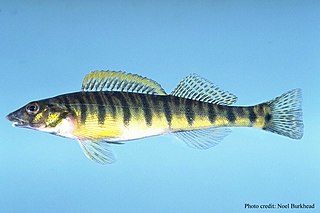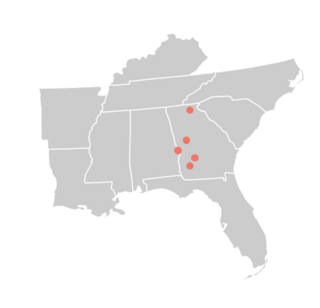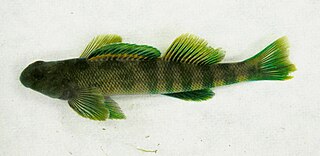
Percina is a genus of small freshwater ray-finned fish, classified within the subfamily Etheostomatinae, part of the family Percidae, which also contains the perches, ruffes and pikeperches from North America. Along with similar fishes in certain other genera, members of Percina are commonly called "darters". More specifically, the genus as a whole is known as roughbelly darters, while certain species of Percina with a pattern of vertical bars on the flanks are called logperches.

Medionidus penicillatus, the gulf moccasinshell, is a rare species of freshwater mussel in the family Unionidae, the river mussels. This aquatic bivalve mollusk is native to Alabama, Florida, and Georgia in the United States, where it is in decline and has been extirpated from most of the rivers it once inhabited. It is a federally listed endangered species of the United States.

The dusky darter is a species of freshwater ray-finned fish, a darter from the subfamily Etheostomatinae, part of the family Percidae, which also contains the perches, ruffes and pikeperches. It is found in, but not confined to, both large and small rivers, and shallow creeks, in the eastern, southern, and southeastern United States, particularly the Mississippi River drainage system.
The brighteye darter is a species of freshwater ray-finned fish, a darter from the subfamily Etheostomatinae, part of the family Percidae, which also contains the perches, ruffes and pikeperches. It is endemic to the eastern United States. The brighteye darter was first described by Oliver Perry Hay in 1885. He noted it is closely related to the banded darter. Until the 1970s, the brighteye darter was generally believed to be a genetic variation of the banded darter.

The gulf darter is a species of freshwater ray-finned fish, a darter from the subfamily Etheostomatinae, part of the family Percidae, which also contains the perches, ruffes and pikeperches. It is found in Louisiana, Mississippi, Alabama, Florida, Tennessee, and Kentucky. It is a colorful fish, males having vertical barring of red-orange and blue-green near the tail, growing to a length of about 7.8 centimeters (3.1 in). It is typically found in small and medium-sized creeks, often in very shallow water. It occurs over sandy bottoms and among aquatic vegetation such as Sparganium americanum, foraging among the plants and organic debris for insect larvae and small invertebrates. The International Union for Conservation of Nature has assessed its conservation status as being of "least concern".
Percina macrocephala, also known commonly as the longhead darter, is a species of freshwater ray-finned fish, a darter in the subfamily Etheostomatinae, part of the family Percidae, which also contains the perches, ruffes, and pikeperches. P. macrocephala is endemic to the United States.

The blackbanded darter is a species of freshwater ray-finned fish, a darter from the subfamily Etheostomatinae, part of the family Percidae, which also contains the perches, ruffes and pikeperches. It is native to the river systems of the southeastern United States where it is found in the states of Tennessee, Georgia, Florida, Mississippi, Alabama, and Louisiana. It lives over sandy or gravelly bottoms in smaller rivers and streams and its color varies depending on the different habitats in which it lives. It feeds on small insect larvae and is itself preyed on by larger fish. It spawns between February and June depending on locality. It is generally a common fish throughout most of its range.
The bronze darter is a species of freshwater ray-finned fish, a darter from the subfamily Etheostomatinae, part of the family Percidae, which also contains the perches, ruffes and pikeperches. It is restricted to the Coosa and Tallapoosa River systems in Georgia, Alabama, and southeastern Tennessee in the United States. It feeds on insect larvae and other small invertebrates, and spawns in April and May. It is a common fish within its range and the International Union for Conservation of Nature has classified its conservation status as being of "least concern". However, it is susceptible to environmental disturbance and an ongoing management plan has been put in place to protect its habitat.
The saddleback darter is a species of freshwater ray-finned fish, a darter from the subfamily Etheostomatinae, part of the family Percidae, which also contains the perches, ruffes and pikeperches. It is native to the eastern United States. This darter species is widespread, occurring from the Escambia River drainage west to the Mississippi River basin and as far north as the Wabash River historically. Some populations have been reported in the Tennessee River drainage. The saddleback darter is aptly named as it has 5 saddle-like patterns on its dorsum, with the first occurring near the first dorsal fin and the fifth near the caudal penduncle. Adults can attain a maximum size of about 3 inches or 7.8 centimeters. The saddleback darter typically occurs over sand and gravel runs of creeks and small to medium-sized rivers and is sometimes found in very shallow water. This darter's diet consists of invertebrates such as caddisfly larvae, beetles, mayflies, and stoneflies. The saddleback darter deposits eggs over sand and gravel shoals during the spring. This species has an average lifespan between 2 and 3 years.
The sickle darter is a recently identified freshwater ray-finned fish, a darter from the subfamily Etheostomatinae, part of the family Percidae, which also contains the perches, ruffes and pikeperches. It is closely related to a well-known darter, Percina macrocephala. Discovered in 2007 in the upper Tennessee River drainage, the sickle darter is around 90.5 mm (3.56 in) in length and is a slender bodied, freshwater and benthopelagic fish that most likely feeds on small crayfish and mayflies, since it shares a large mouth and long snout with its sister species. The known distribution of the sickle darter is the upper drainage of the Tennessee River of Tennessee, North Carolina and Virginia. It is distinguished from all other Percina darters except its sister species P. macrocephala by a dark suborbital bar and a black bar subtending a medial black spot on the base of the caudal fin. It stays in mostly rocky, sandy, or silty substrates in clear creeks or small rivers in the Appalachian Mountains. The sickle darter spawns in late winter in gravel shoals. It also has large scales which make it different from macrocephala. It is known to be extirpated from most of its home habitat mainly because of agricultural practices that cause siltation and turbidity which causes most populations of the sickle darter to be widely scattered. But where it is found, it can be observed with regularity. Taking all this into consideration, the sickle darter does not have a formal conservation status under any federal or state law although its closely related species is considered a species of concern by the TWRA. Future management plans should include finding more locations of the sickle darter and decreasing further habitat destruction in known distributions by stating it as a fish of concern by state law.
Percina peltata, the shield darter, is a species of freshwater ray-finned fish, a darter from the subfamily Etheostomatinae, part of the family Percidae, which also contains the perches, ruffes and pikeperches. It is endemic to the eastern United States.

Percina roanoka, the Roanoke darter, is a species of freshwater ray-finned fish, a darter from the subfamily Etheostomatinae, part of the family Percidae, which also contains the perches, ruffes and pikeperches. It is native to Virginia and North Carolina in the United States and is present in West Virginia, possibly from introduction. It is found in the Roanoke, Tar, and Neuse river systems, typically in small to medium size rivers. It is a colorful species with an average length of 4.3 centimeters (1.7 in). It feeds on insect larvae and other small invertebrates, and spawns in late May and June. It is a common fish with a very wide range and the International Union for Conservation of Nature has classified its conservation status as being of "least concern".

The Guadalupe darter is a small species of freshwater ray-finned fish, a darter from the subfamily Etheostomatinae, part of the family Percidae, which also contains the perches, ruffes and pikeperches. It is found in the Guadalupe River system in Texas. The Guadalupe darter was formally a subspecies of the dusky darter, but was recognized as an independent species in 2007. It is protected by state law as a threatened species.

The Chesapeake logperch is a small species of freshwater ray-finned fish, a darter from the subfamily Etheostomatinae, part of the family Percidae, which also contains the perches, ruffes and pikeperches. It is found in the Chesapeake Bay drainages. It prefers gravel runs and riffles of small to medium-sized rivers.
The coal darter is a small species of freshwater ray-finned fish, a darter from the subfamily Etheostomatinae, part of the family Percidae, which also contains the perches, ruffes and pikeperches. It is found in eastern Mobile Bay basin, Alabama. The species' stronghold is in the main channel of the Cahaba River, primarily above the Fall Line. It prefers gravel runs and riffles of small to medium-sized rivers.

The Halloween darter is a small freshwater fish native to North America. It is found in Georgia and Alabama in the drainage basin of the Apalachicola River, specifically in the Flint River system and the Chattahoochee River system. It prefers shallow, fast-flowing areas with gravel bottoms in small and medium-sized rivers. It was first described in 2008, having not previously been distinguished from the Blackbanded darter (P. nigrofasciata), formerly thought to occur in the same watershed. Blackbanded darter has since been split again with Westfall's darter now recognised from the Apalachicola drainage. The species is somewhat variable, being generally blackish dorsally, with some individuals having indistinct saddle-like barring. Males have orange and dark lateral striping while females have dark stripes and a yellowish-green belly. At a maximum standard length of 101 mm (4 in), males are slightly larger than females, and both sexes develop distinctive orange barring on the edge of the first dorsal fin during the breeding season.
The bigscale logperch is a species of freshwater ray-finned fish, a darter from the subfamily Etheostomatinae, part of the family Percidae, which also contains the perches, ruffes and pikeperches. It is native to North America where it occurs in the Sabine River of Louisiana, the Red River of Oklahoma and Arkansas, and to the Rio Grande drainage of Texas, New Mexico, and Mexico. It is now widespread in the Arkansas River basin where it was likely introduced. It was introduced to the Sacramento-San Joaquin River drainage in central California, and in reservoirs fed by the California Aqueduct where it is also widespread.
The sharpnose darter is a species of freshwater ray-finned fish, a darter from the subfamily Etheostomatinae, part of the family Percidae, which also contains the perches, ruffes and pikeperches. It is found in North America where it occurs in the southern tributaries of upper Ohio River, to the Kentucky River in Kentucky, south in the New River drainage to North Carolina. It prefers gravel runs and riffles of small to medium-sized rivers.
The Gulf logperch is a small species of freshwater ray-finned fish, a darter from the subfamily Etheostomatinae, part of the family Percidae, which also contains the perches, ruffes and pikeperches. It is found in North America where it occurs in the coastal river systems Of the Gulf of Mexico from Lake Pontchartrain drainages east through the Pearl and Pascagoula drainages to the Mobile basin. It prefers gravel runs and riffles of small to medium-sized rivers. This species was first formally described in 1992 by Bruce A. Thompson (1946-2007) with the type locality given as the Pearl River at river mile 46.8, below pools at Bluff Sill, about 6 kilometers south of Bogalusa, Louisiana, near Louisiana Highway 21 in Pearl River County, Mississippi.

Etheostomatinae is a species-rich subfamily of freshwater ray-finned fish, the members of which are commonly known as the darters. The subfamily is part of the family Percidae which also includes the perches, ruffes and pikeperches. The family is endemic to North America. It consists of three to five different genera and well over 200 species. A common name for these fish in southern Indiana is pollywog.










